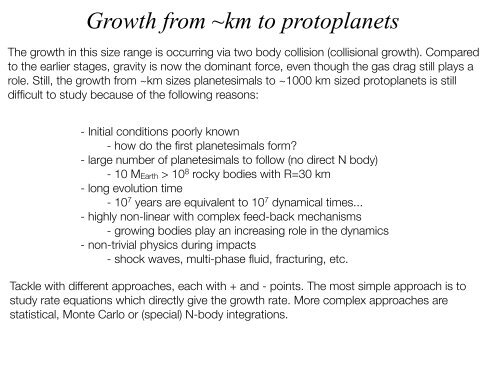L10 From Planetesimals to protoplanets
L10 From Planetesimals to protoplanets
L10 From Planetesimals to protoplanets
Create successful ePaper yourself
Turn your PDF publications into a flip-book with our unique Google optimized e-Paper software.
Growth from ~km <strong>to</strong> pro<strong>to</strong>planets<br />
The growth in this size range is occurring via two body collision (collisional growth). Compared<br />
<strong>to</strong> the earlier stages, gravity is now the dominant force, even though the gas drag still plays a<br />
role. Still, the growth from ~km sizes planetesimals <strong>to</strong> ~1000 km sized pro<strong>to</strong>planets is still<br />
difficult <strong>to</strong> study because of the following reasons:<br />
- Initial conditions poorly known<br />
- how do the first planetesimals form?<br />
- large number of planetesimals <strong>to</strong> follow (no direct N body)<br />
- 10 MEarth > 10 8 rocky bodies with R=30 km<br />
- long evolution time<br />
- 10 7 years are equivalent <strong>to</strong> 10 7 dynamical times...<br />
- highly non-linear with complex feed-back mechanisms<br />
- growing bodies play an increasing role in the dynamics<br />
- non-trivial physics during impacts<br />
- shock waves, multi-phase fluid, fracturing, etc.<br />
Tackle with different approaches, each with + and - points. The most simple approach is <strong>to</strong><br />
study rate equations which directly give the growth rate. More complex approaches are<br />
statistical, Monte Carlo or (special) N-body integrations.

















